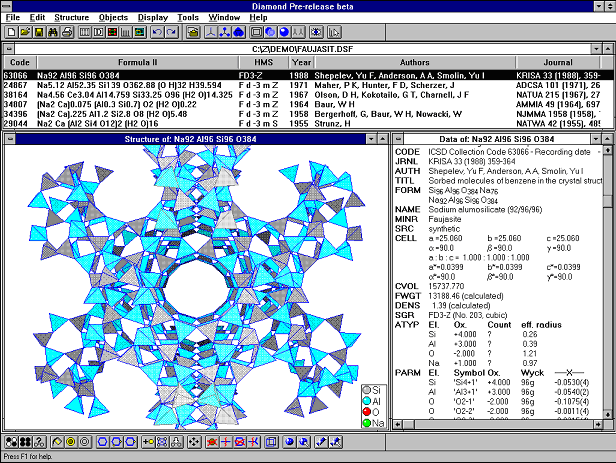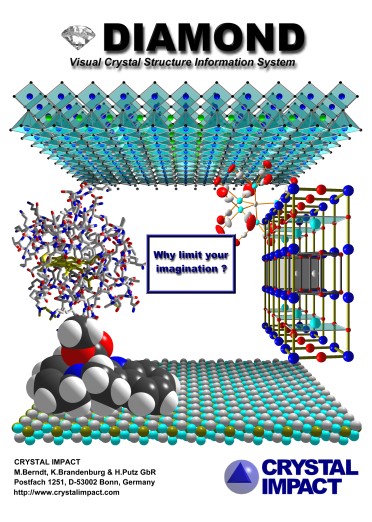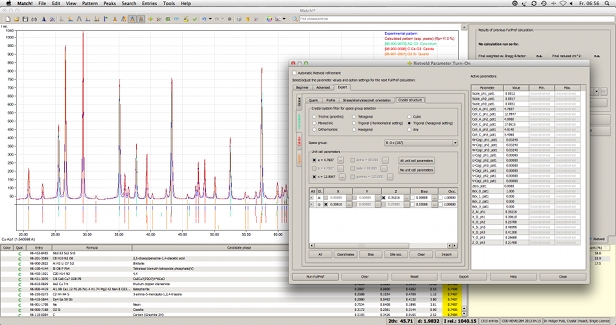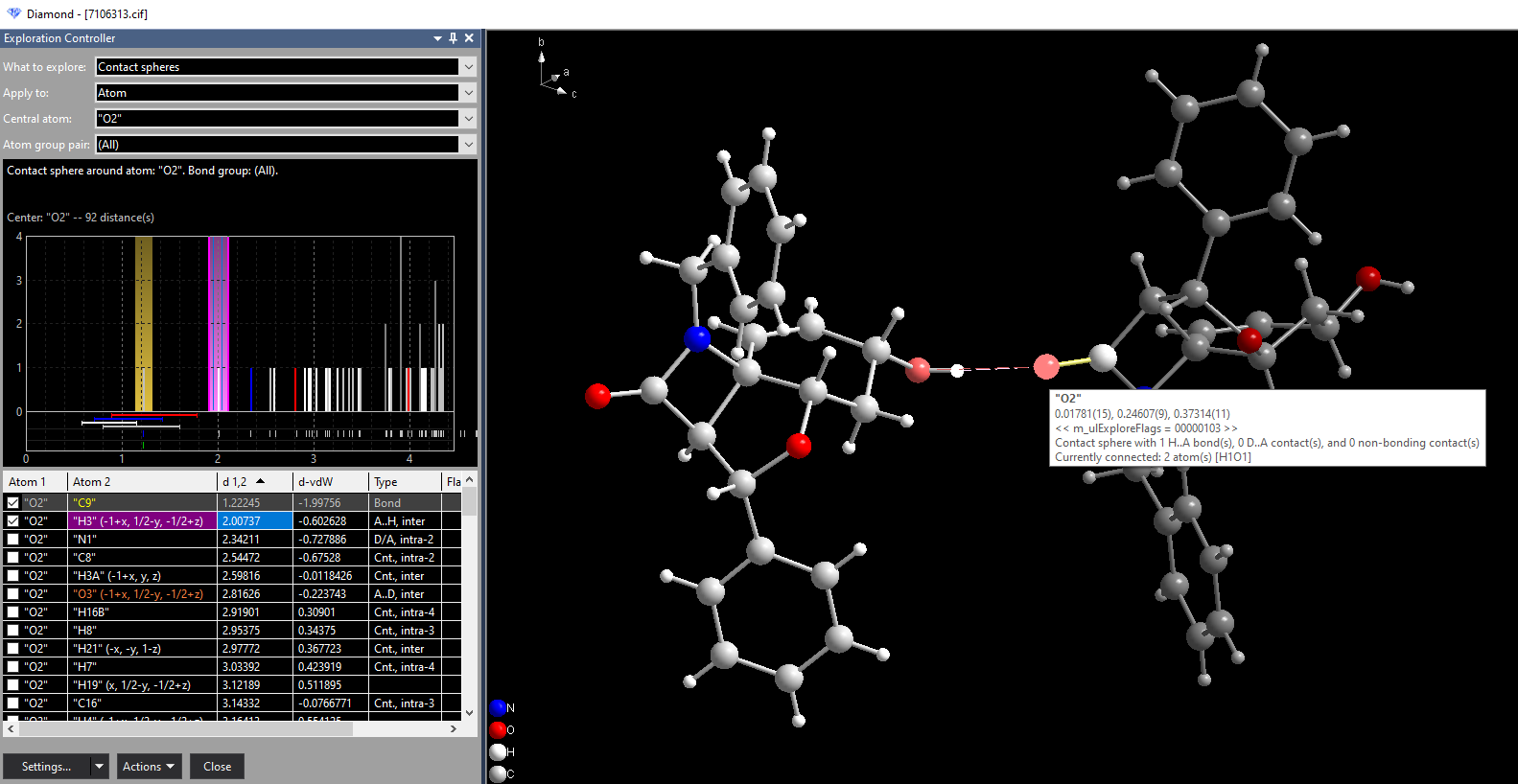25 Years of Crystal Impact
This year, Crystal Impact already celebrates its 25th anniversary! Please read what happened since its foundation in 1997:
Foundation
Crystal Impact was founded on November 1, 1997 by Dr. Michael Berndt and Dr. Klaus
Brandenburg as a successor of the "Prof. Dr. G. Bergerhoff Software-Entwicklung". By that
time, the first version of Diamond was already available (since July 1995),
looking like this:

First product: Diamond
About half a year after the foundation of Crystal Impact, in June 1998 version 2
of Diamond was released, and Michael and Klaus presented it on the ECM-18 in Prague
in August 1998. The key feature of this new
version was the shaded representation of atoms, bonds, etc., making use of the
OpenGL 3D graphics library. The poster below shows a composition of different kinds of
structures showing the new capabilities of version 2, such as
transparency, space-filling with correct overlap, shaded ellipsoids etc.

Move
The Crystal Impact office in the early years was still located at the University of Bonn.
However, the original room became too small for a professional working company. As a result,
Crystal Impact moved to a new large office in a foundation center "just around the corner" (Immenburgstr. 20 in Bonn, Germany) at the end/beginning of 1999/2000.
Second product: Endeavour
On November 15, 2000, Crystal Impact released a new innovative product called "Endeavour".
The focus of this software was the solution of crystal structures from powder diffraction
data. From a technical point of view, the software resulted from merging Diamond and
a program called "Diff42", developed by Dr. Holger Putz, which performed the actual calculations (the "Endeavour kernel"). Very early versions had already been presented
on DGK meeting Leipzig (March 1999) and IUCr meeting Glasgow (August 1999) by Holger
and Michael.
For more infos about Endeavour, read here...
New partner
On January 1, 2001, Dr. Holger Putz was admitted as a new partner.
Pauling File project
A new product was announced since 2000 and launched in April 2002: "Pauling File,
Binaries Edition". The Pauling File project was already launched in 1995 by Pierre Villars et. al. with the aim to create tools for
scientists working with inorganic compounds, with particular focus on materials
design. As a first step, a comprehensive, phase-oriented database was being built up.
"Pauling File, Binaries Edition" was an innovative product by that time, merging crystal structure data of non-organic compounds (no C-H bonds) with phase diagrams,
diffraction data, and physical property data. Though the project covers
all binary, ternary and multinary, non-organic
compounds (no C---H bonds), the first edition was limited to binary compounds (http://dx.doi.org/10.1016/j.jallcom.2003.08.058).
Unfortunately, the producing company Material Phases Data System (MPDS, P. Villars) had to interrupt further development
of this extremely promising and ambitious product due to funding problems.
Nevertheless, the Binaries Edition has been further developed since then and is now available as the ASM Materials Platform for Data Science at ASM International.
Sad news
Dr. Michael Berndt, one of the three Crystal Impact partners, died on June 30th, 2003 after a long, serious illness
at the age of 39. Obituary...
Third product: Match!
On September 22, 2003, "Match!", a new software for phase analysis using powder diffraction data,
was released. Being initially designed as a low-price alternative to existing solutions,
the program quickly showed its separative power, with customers reporting the identification
of previously unknown phases and mixtures.
Diamond version 3
Crystal Impact's engagement in software development for Pauling File in the
years 2000 through 2002 and
Michael's death on June 30, 2003, caused multiple delays in the
development of the next major version 3, which was finally released on
October 15, 2004. Amongst several new features like POV-Ray graphics
export, powder pattern simulation, this new version can process more than one
structure parameter set in a document (file) as well as multiple pictures for a
structure parameter set each.
New crystal structure database: Pearson's Crystal Data
On February 22, 2007, Crystal Impact announced the distribution of a new crystal structure database
for inorganic compounds, Pearson's Crystal Data, or short "PCD". Editors-in-chiefs are Pierre Villars and Karin Cenzual, who have already been working for a long time on the Pauling File project, see above.
The database comes with an innovative and thought-out Windows user interface developed by
Crystal Impact. The PCD product is published by
ASM International with Crystal Impact as one of the re-sellers.
For more infos about PCD, read here...
10 years of Crystal Impact
In 2007, Crystal Impact celebrated its 10th anniversary.
Moves #2 and #3
After almost eight years in the Immenburgstrasse, Crystal Impact moved to a new office
in November 2007 (Rathausgasse 30, D-53111 Bonn). Today - after a third move in March 2012 - the office is located in the Kreuzherrenstr. 102, 53227 Bonn.
New version of Match!
The first version of Match! only offered very basic features for phase identification from powder. Hence, the functionality was extended step by step in the following years. For example, support for the well-known ICDD PDF database products (Match! version 1.2) as well as the Crystallography Open Database (COD) (Match! version 1.7) was added, so that they could be used as reference databases.
Finally, in May 2012, Match! version 2 was released. These almost 10 years of development were not only used for adding new functionality to Match!, but also to make the software available for macOS and Linux computers. For this, a nearly complete re-writing of the software code became necessary, in order to adapt it to using the cross-platform Qt run-time library.

But there was even more behind the scenes. Please read Holger's "Ten Years of Match!" article describing in more detail what happened between 2003 and 2012. For example, there was a "secret" version 2 prototype that never made its way to publication...
The long awaited version 4 of Diamond
It took many years - too many years: ten years - between version 3 and 4 of Diamond. The long awaited version was released in October 2014. For more details about the Diamond history, read our "Twenty Years of Diamond" article.
New license types and model
Also in the year 2014, we introduced new, additional license types for our software products Diamond, Endeavour, and Match! (but not for PCD): the "Personal Licenses", which were only available for individuals and could not be purchased by institutions or used for commercial purposes. Because of this, we believed that we could offer them for a really low price (but see below).
Besides this, we started to switch over to the new "update permission time model", beginning with the release of Match! version 3 in the summer of 2015.
With this new update model, we will be able to continuously develop our software and add new functionality (and bug fixes) as it comes along, without having to think about keeping a highlighting new feature back for a potential future major update. In the near future, Diamond will also start using this new model when its next major updates (Diamond 5) will become available. You can find more about the update permission time model here...
Onlinestore opened on February 11, 2019
In February 2019, we started offering licenses for our software products in our new online store, in addition to the classical order form approach that we have used exclusively until then.
One of the main advantages of this online store is that customers can enter their credit card data in a secure environment and do not have to send them to us e.g. on an order form.
Discontinuation of Permanent Personal Licenses after December 31, 2020
In 2020 we became aware of a significant problem associated with our permanent personal license offer: Quite a lot of customers asked for the difference between a permanent personal license and an academic single license.
While the former was in principle only available for individuals but not for institutional customers, it turned out that in practice it was sometimes difficult to clearly distinguish between these two types of customers. For example, we had quite a lot of cases where customers (individuals) received donations from academic foundations they wanted to use for purchasing the licenses.
In the end, we came to the conclusion that we could only avoid these difficulties by introducing a clearer separation between personal licenses for individuals (by making them only available as time-limited licenses) and permanent licenses for institutions. As a result, we stopped offering permanent personal licenses at the end of 2020.
Discontinuation of all Personal Licenses after June 30, 2022
Our original motivation with personal licenses was that they would allow us to to provide licenses for our software packages to individuals with reduced budget, by offering them at the absolutely lowest prices that we believed we could afford. However, in summer 2022 we finally had to realize that selling them was not cost-covering at all, unfortunately. Being just a very small company, we were not able to carry non-cost-covering offers, so after long discussions we finally decided to stop offering personal licenses after June 30, 2022.
New License Type: Introduction of Annual Licenses on July 1, 2022
As some kind of replacement for the discontinued personal licenses, we started to offer so-called "annual licenses" that are available for all customers in July 2022.
Current Status
Since more than a quarter of a century, Crystal Impact is a well-known developer of crystallographic
and related software products, with more than 1,500 institution customers in 93 countries all around the world. Crystal Impact currently offers three different own products
(Diamond, Endeavour,
and Match!) and one crystallographic database
(Pearson's Crystal Data).
Here is a survey of these products.
Outlook
We are currently busy preparing the release of the next Diamond version 5,
providing the innovative and long-awaited "Exploration View":

In addition, we are working on a more comfortable installation of your license files. It will first become available with the next version of Match!.
For Diamond as well as Match! we have a long list of improvements and innovative features to-be-added that we will implement and make available for you continuously.
In the long run we are thinking about new elaborate software products in the area of
crystallography and powder diffraction.
|

